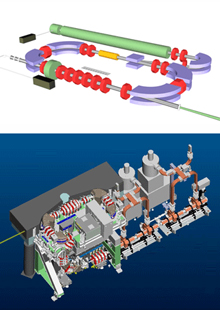A Miniature Synchrotron
Synchrotrons are huge facilities that can produce intense, high-quality x-ray beams for scientific purposes. They usually span the size of a football field and cost hundreds of millions of dollars to build and operate. But now, researchers at Lyncean Technologies, a startup in Palo Alto, CA, have shrunk the synchrotron to the size of a room. This miniature synchrotron offers scientists a new way to perform high-quality x-ray experiments in their own labs.

Lyncean has built a prototype synchrotron and is constructing another to be installed this year at the Scripps Research Institute in La Jolla, CA. The new synchrotron will be used by the Accelerated Technologies Center for Gene to 3D Structure, which is part of the National Institutes of Health’s Protein Structure Initiative.
The tabletop instrument is “not as powerful as the big synchrotrons,” says Ronald Ruth, Lyncean’s president and chief scientist. “But on the other hand, it’s far cheaper, and it’s very compact.” He likens the national synchrotrons to supercomputers, where many users must compete for limited time on one of the beams. “[The synchrotrons] address the state-of-the art,” Ruth says. “They push the envelope. But their impact is only as broad as the number of people that are willing to travel to go there.” The miniature synchrotron is more like a PC, he says, shared by a few users and readily available.
X-rays are useful in probing the properties of materials, since their wavelength is about the same size as atoms and the chemical bonds between them. For example, x-ray crystallography is an important method in determining protein structure. X-rays diffract as they pass through a protein crystal, generating a characteristic interference pattern. By analyzing the pattern, scientists can deduce the arrangement of the atoms and thus determine the protein’s structure.
For these kinds of studies, synchrotron radiation has advantages over ordinary x-ray sources: It’s a hundred million times brighter and highly concentrated, which allows for very precise, high-resolution experiments. Synchrotrons also produce a continuous source of x-rays, instead of the short bursts generated from common x-ray tubes. And a synchrotron’s light is tunable, so researchers can match the energy to the material being probed.
The quality of light from the miniature synchrotron is as good as the big machines, says Franz Pfeiffer, a physicist at the Paul Scherrer Institute and École Polytechnique Federale in Lausanne, Switzerland. “That’s what makes it so attractive,” he says. “[It] combines the benefit of having something relatively small with the advantages of the extremely brilliant beam that is available through synchrotrons. It’s a very nice thing to have.”
Ruth first determined that a miniature synchrotron might be possible in the late 1990s, when hewas a professor at the Stanford Linear Accelerator Center. Ruth and a graduate student, Zhirong Huang, were looking for a way to cool electron beams by getting them to radiate. They found that hitting the beams with a laser not only cooled them effectively, but also generated x-rays.
This effect proved to be the key to shrinking the synchrotron down to size. Big synchrotrons use magnetic “undulators” that wiggle the electron beam from side to side as it circulates around a large storage ring. Ruth explains that that wiggle, on the order of one centimeter, generates x-rays that are thrown off on a tangent to the circle, much like a spinning searchlight shines light.
The miniature synchrotron uses only a moving laser pulse that interacts with the electron beam each time it goes around the storage ring, which fits on a tabletop. The wiggle is one ten thousandth as small–just one micrometer–and the x-rays are given off in a single beam.
Keep Reading
Most Popular
Large language models can do jaw-dropping things. But nobody knows exactly why.
And that's a problem. Figuring it out is one of the biggest scientific puzzles of our time and a crucial step towards controlling more powerful future models.
The problem with plug-in hybrids? Their drivers.
Plug-in hybrids are often sold as a transition to EVs, but new data from Europe shows we’re still underestimating the emissions they produce.
Google DeepMind’s new generative model makes Super Mario–like games from scratch
Genie learns how to control games by watching hours and hours of video. It could help train next-gen robots too.
How scientists traced a mysterious covid case back to six toilets
When wastewater surveillance turns into a hunt for a single infected individual, the ethics get tricky.
Stay connected
Get the latest updates from
MIT Technology Review
Discover special offers, top stories, upcoming events, and more.